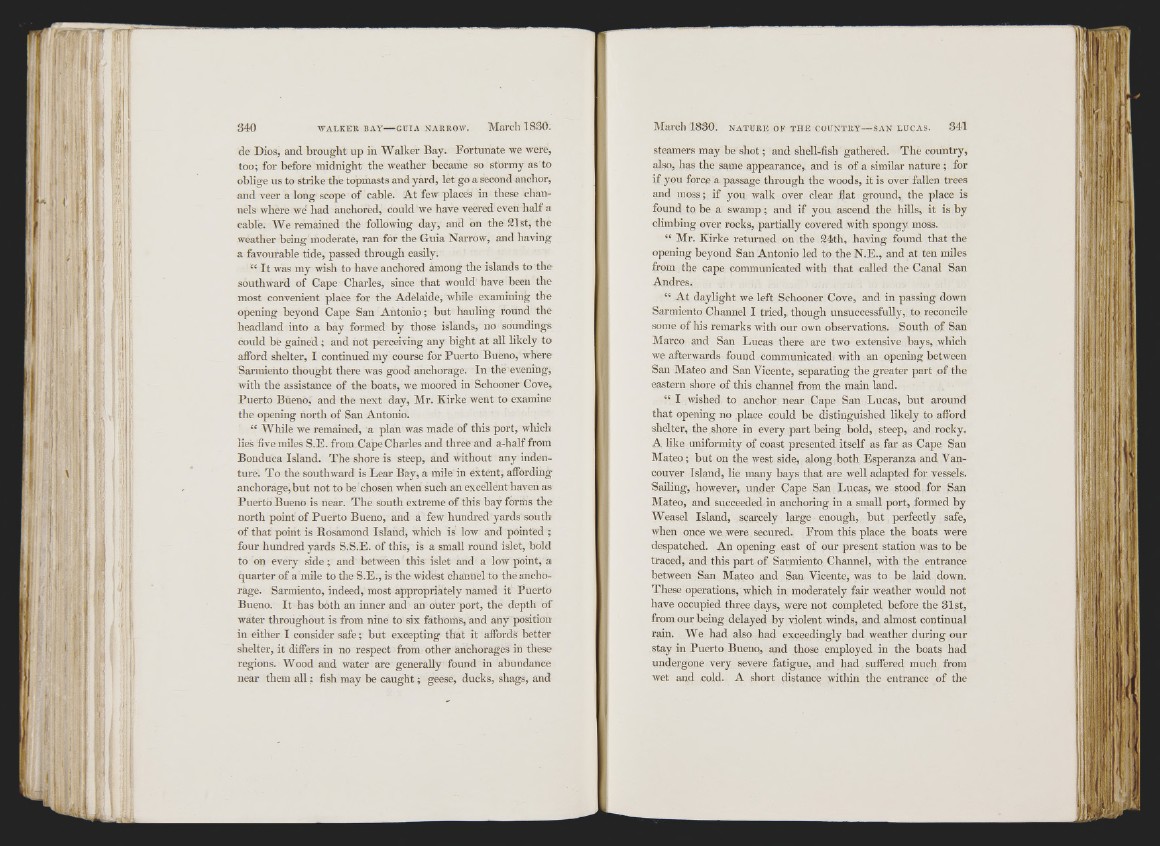
3 4 0 WALK ER BAY GDIA NARROW. A'laVcIl 1 8 3 0 .
de Dios, and brought up in AA^alker Bay. Fortunate we were,
too; for before midnight the weather became so stormy as to
oblige ns to strike the topmasts and yard, let go a second anchor,
and veer a long scope of cable. At few places in these channels
where we had anchored, could we have veered even half a
cahle. W e remained the following day, and on the 21st, the
weather being moderate, ran for the Guia Narrow, and having
a favourable tide, passed through easily.
“ It was my wish to have anchored among the islands to the
southward of Cape Charles, since that would have been the
most convenient place for the Adelaide, while examining the
opening beyond Cape San Antonio; but hauling round the
headland into a hay formed by those islands, no soundings
could be gained ; and not perceiving any bight at all likely to
afford shelter, I continued my course for Puerto Bueno, where
Sarmiento thought there was good anchorage. In the evening,
with the assistance of the boats, we moored in Schooner Cove,
Puerto Bueno, and the next day, Mr. Kirke went to examine
the opening north of San Antonio.
“ AVhile we i-emained, a plan was made of this port, which
lies five miles S.E. from Cape Charles and three and a-half from
Bonduca Island. The shore is steep, and without any indenture.
To the southward is Lear Bay, a mile in extent, affording
anchorage, but not to be chosen when such an excellent haven as
Puerto Bueno is near. The south extreme of this bay forms the
north point of Puerto Bueno, and a few hundred yards south
of that point is Rosamond Island, which is low and pointed ;
four hundred yards S.S.E. of this, is a small round islet, bold
to on every side; and between this islet and a low point, a
quarter of a mile to the S.E., is the widest channel to the anchorage.
Sarmiento, indeed, most appropriately named it Puerto
Bueno. It has both an inner and an outer port, the depth of
water throughout is from nine to six fathoms, and any position
in either I consider safe; but excepting that it affords better
shelter, it differs in no respect from other anchorages in these
regions. AVood and water are generally found in abundance
near them a ll; fish may be caught; geese, ducks, shags, and
March 1830. n a t u r e o f t h e c o u n t r y — s a n l u c a s . 341
steamers may be shot ; and shell-fish gathered. The country,
also, has the same appearance, and is of a similar nature ; for
if you force a passage through the woods, it is over fallen trees
and moss; if you walk over clear flat ground, the place is
found to be a swamp ; and if you ascend the hills, it is by
climbing over rocks, partially covered with spongy moss.
“ Mr. Kirke returned on the 24th, having found that the
opening beyond San Antonio led to the N.E., and at ten miles
from the cape communicated with that called the Canal San
Andres.
“ At daylight we left Schooner Cove, and in passing down
Sarmiento Channel I tried, though unsuccessfully, to reconcile
some of his remarks with our own observations. South of San
Marco and San Lucas there are two extensive bays, which
we afterwards found communicated with an opening between
San Mateo and San Vicente, separating the greater part of the
eastern shore of this channel from the main land.
“ I wished to anchor near Cape San Lucas, but around
that opening no place could be distinguished likely to afford
shelter, the shore in every part being bold, steep, and rocky.
A like uniformity of coast presented itself as far as Cape San
Mateo; but on the west side, along both Esperanza and Vancouver
Island, lie many bays that are well adapted for vessels.
Sailing, however, under Cape San Lucas, we stood for San
Mateo, and succeeded in anchoring in a small port, formed by
AVeasel Island, scarcely large enough, hut perfectly safe,
when once we were secured. From this place the boats were
despatched. An opening east of our present station was to be
traced, and this part of Sarmiento Channel, with the entrance
between San Mateo and San Vicente, was to be laid down.
These operations, which in moderately fair weather would not
have occupied three days, were not completed before the 31st,
from our being delayed by violent winds, and almost continual
rain. AVe had also had exceedingly bad weather during our
stay in Puerto Bueiio, and those employed in the boats had
undergone very severe fatigue, and had suffered much from
wet and cold. A short distance within the entrance of the
ini
Pi!
m
jj ■ 'I